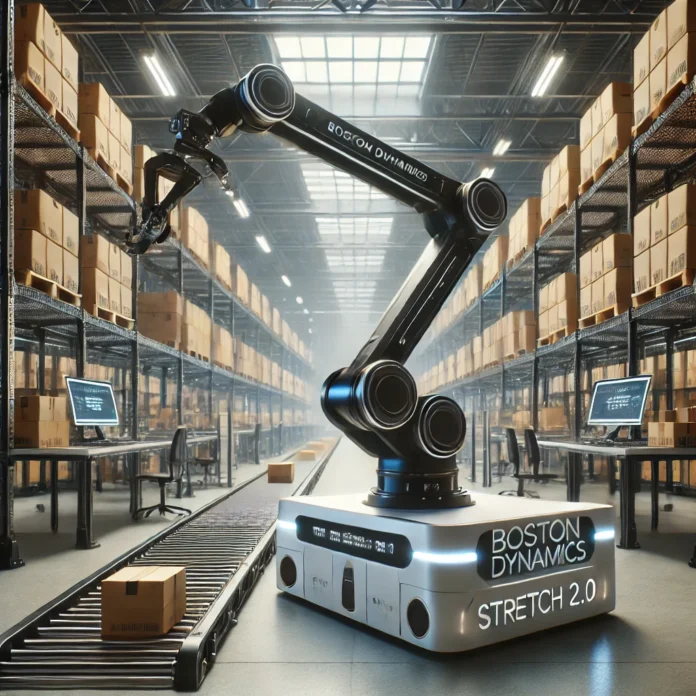Boston Dynamics has introduced the next generation of its warehouse automation solution with the launch of Stretch Robot 2.0, promising significant efficiency improvements for logistics operations. The updated mobile robot features enhanced AI capabilities, increased payload capacity, and a more intuitive user interface designed to simplify deployment across various warehouse environments.
Enhanced Capabilities for Modern Warehouses
The Stretch 2.0 builds upon the success of its predecessor with several key improvements aimed at addressing the growing demand for flexible automation solutions in the logistics sector. According to Boston Dynamics, the new model can handle packages weighing up to 75 pounds (34 kg)—a 50% increase from the original version—while maintaining the same mobility and adaptability that made the first-generation Stretch popular among early adopters.
«Warehouse operators have been asking for robots that can handle heavier items without sacrificing speed or precision,» said Robert Playter, CEO of Boston Dynamics, during yesterday’s virtual product launch event. «Stretch 2.0 delivers on that request while also introducing new AI capabilities that make it easier than ever to integrate robotics into existing workflows.»
Among the most notable new features is the robot’s advanced computer vision system, which uses deep learning algorithms to identify and adapt to a wider variety of package types and stacking configurations. This enhancement enables Stretch 2.0 to work effectively in more diverse environments with minimal programming or supervision.
Market Timing Amid Labor Shortages
The launch comes at a critical time for the logistics industry, which continues to face persistent labor shortages and increasing e-commerce demand. According to recent data from the Bureau of Labor Statistics, warehousing and transportation sectors still have approximately 12% more job openings than available workers, creating strong market conditions for automation solutions.
Industry analyst Maria Chen from Robotics Research Group commented on the timing: «Boston Dynamics is positioning Stretch 2.0 as a solution to the ongoing labor challenges in logistics. The increased payload capacity and improved ease of use directly address feedback from early customers who wanted to automate more of their heavy-lifting operations.»
Technical Specifications and Improvements
Stretch 2.0 retains the mobile base and extensible arm design of the original model but features several technical improvements:
- Enhanced vision system capable of recognizing and adapting to more package types
- Reinforced gripper design with adaptive pressure sensing
- Improved battery life allowing for up to 10 hours of continuous operation
- New user interface designed for warehouse staff without robotics expertise
- Cloud-based fleet management system for coordinating multiple units
The robot’s mobility remains one of its key selling points, allowing it to navigate standard warehouse aisles and adapt to different workstations without requiring facility modifications.
Industry Response and Market Outlook
Early feedback from beta testers has been positive, with several major logistics providers already placing orders for the new model. DHL Supply Chain, which has been testing pre-production units since January, reported a 27% increase in unloading efficiency compared to the previous generation.
«The ability to handle heavier packages allows us to automate more processes that previously required manual handling,» said Thomas Rodriguez, VP of Innovation at DHL Supply Chain. «We’ve been particularly impressed with how quickly new staff can learn to work alongside these robots.»
Market analysts project the warehouse robotics sector to grow at a CAGR of 15% through 2030, with mobile picking and unloading robots like Stretch representing the fastest-growing segment. Boston Dynamics’ focus on ease of use and deployment flexibility appears well-aligned with market demands.
Pricing and Availability
Boston Dynamics has adopted a Robot-as-a-Service (RaaS) model for Stretch 2.0, with subscription pricing starting at $15,000 per month for a minimum 24-month commitment. This approach reduces upfront capital requirements for customers while including maintenance and software updates.
The company has begun accepting orders with initial deployments scheduled for July 2025. A limited number of evaluation units are available for qualified customers who want to assess the robot’s performance in their specific environments before committing to a full deployment.
Broader Implications for Warehouse Automation
The introduction of Stretch 2.0 reflects a broader trend toward more adaptable automation solutions in logistics. Unlike fixed infrastructure systems, mobile robots like Stretch can be deployed quickly and redeployed as needs change.
«We’re seeing a clear shift away from the massive, facility-wide automation projects that dominated the last decade,» noted Chen. «Companies now prefer flexible solutions that can be implemented incrementally and adjusted based on real-world performance data.»
Boston Dynamics, which was acquired by Hyundai Motor Group in 2021, has significantly expanded its commercial robotics portfolio in recent years. While the company was previously known for more experimental projects like the quadruped robot Spot and the humanoid Atlas, its focus has increasingly shifted toward practical applications in industries facing labor challenges.
As warehouse automation continues to evolve, solutions like Stretch 2.0 represent an important middle ground between fully manual operations and the highly automated distribution centers pioneered by companies like Amazon Robotics, making advanced robotics accessible to a broader range of logistics providers.




